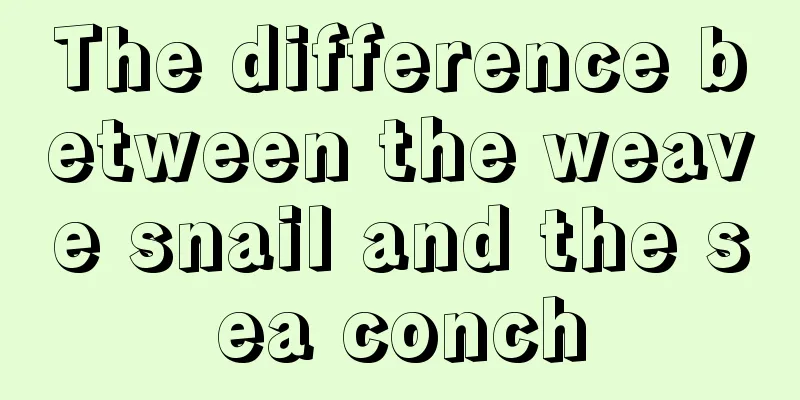The difference between the weave snail and the sea conch

|
The cone snail and sea conch look similar, but there are huge differences between them. For example, the cone snail cannot be eaten because it can cause serious poisoning, while the sea conch can be eaten and has a relatively high nutritional value. In Shandong, conch is also called clams. It tastes delicious and has high nutritional value. The snail itself is not poisonous, but due to some chemical reasons such as red tide, the toxins in the snail are gradually increasing. The difference between the weaving snail and the sea conch Let’s first talk about the silkworm snail, commonly known as the sea silk snail, which is produced in the coastal areas of Zhejiang, Fujian and Guangdong. The appearance characteristics of the textured snail are that its tail is pointed and slender, about 1 cm long and 0.5 cm wide, about the size of a fingernail. The snail itself is not poisonous, but its deadly toxicity is caused by the ingestion of toxic algae in red tide. The main toxin of the snail that causes food poisoning is paralytic shellfish toxin, which is similar to pufferfish toxin. Due to the large-scale discharge of industrial wastewater and domestic sewage, the seawater becomes eutrophic, and red tides frequently occur in the South China Sea, East China Sea, Bohai Sea and Yellow Sea in different seasons. Some of the algae that proliferate in large numbers during red tides can produce toxins, and the snails accumulate toxins by eating toxic algae or other toxic substances (such as pufferfish toxin). The poisoned patients mainly suffer from neurological paralysis symptoms and the mortality rate is high. Let’s talk about the clams that Shandong people often eat, also known as sea snails, whose scientific name is Aspleniopteryx, a species of the family Conchocystidae. The shell is tower-shaped, about 2 cm long, with a slightly thin and solid shell, usually 8 layers of whorls, the shell surface is yellow-white, the shell bottom is white, the shell mouth is oval, and there are fine grooves on the inside. They mostly live in the middle and upper tidal areas of the intertidal zone. After low tide, they crawl on the mudflats or muddy beaches in the intertidal zone, or hide in shady places next to rocks. The average habitat density is 4/square meter. They are distributed along the coast of the Yellow Sea. They are the most common species in brackish and fresh water near river estuaries. Most fishermen go to sea to fish after the tide goes out. The blunt-headed crab snail has a very sharp end like a cone, so people call it sea cone. People in Qingdao call it clams. They usually boil it in water and take it out when guests come. They eat it just like city people eat melon seeds. The meat is very delicious and can usually be picked out with a pin. If you can't eat it, cut off the tail of the clam and suck it with your mouth. The snail meat is only tiny in size, but its fresh and tender taste is probably irreplaceable by anything else. Clams and sea snails are similar in appearance, and it is difficult to tell the difference between the two, but there is a slight difference in color. Clams are yellowish in color, while sea snails are gray-black. When purchasing, you can distinguish clams and sea snails based on color. Is sea snail a weaving snail? No, sea snails belong to the gastropod mollusk. It is produced on the seabed of shallow coastal waters, mostly in Shandong, Liaoning and Hebei, and the production period is from May to August. The edge of the conch shell is slightly square, large and thick, with a shell height of about 10 cm, 6 whorls, and the inside of the shell mouth is apricot red with a pearly luster. The snail meat is plump and delicate, with delicious taste, and is known as the "pearl on the plate". Nutritional value of sea snails The grass silkworm can be used as both food and medicine, and its nature and flavor are sweet and flat; It can dispel wind and heat, promote blood circulation and remove blood stasis, detoxify and reduce swelling, moisten the lungs and benefit the kidneys, nourish yin and blood, and strengthen the body; It can treat colds, fever, cough, jaundice, asthma, lung deficiency cough and asthma, kidney deficiency and low back pain, lymph tuberculosis, pulmonary tuberculosis, hemoptysis and other diseases. The above-ground stems and leaves can also treat rheumatoid arthritis, hepatitis, snake bites, and relieve blood stasis and pain. |
<<: What should I pay attention to after getting a tattoo
>>: What's wrong with the pain on the side of the waist
Recommend
Will gastric bleeding heal on its own without treatment?
The stomach is the most important digestive organ...
On which day after chemotherapy for breast cancer does the reaction become severe
On which day after chemotherapy does the reaction...
Life tips that girls must know
Life tips refer to the knowledge and experience s...
The efficacy and function of magnetic underwear
Major businesses have racked their brains to laun...
Can liver cancer patients eat bird's nest?
Liver cancer patients mainly need to take care of...
What should I do if my heart suddenly beats too fast?
The heartbeat is generally gentle. If the heartbe...
How did the cold get better
When people have a cold, they often have symptoms...
What are the early symptoms of lung cancer? These are the early symptoms of lung cancer
Lung cancer is a malignant tumor that seriously e...
What to do if you have lost your eyesight and have many dreams and poor sleep quality
According to surveys, today's adults sleep le...
The best way to detoxify the blood
Some toxins can be naturally excreted through fil...
There is a lot of phlegm in the throat and the phlegm is stuck in the throat
It is very common in daily life to have a lot of ...
What to do if teeth are yellow and smelly
When communicating with others, if there is bad s...
What is the most effective way to treat pleural effusion caused by lung cancer? What are the treatments for lung cancer?
How to use medicine for pleural effusion caused b...
Are all colds contagious?
Everyone should have noticed that if someone arou...
What causes numbness in arms and fingers?
Numbness in the arms and fingers is a condition t...









